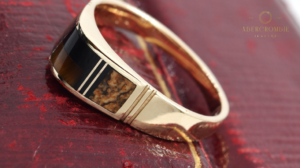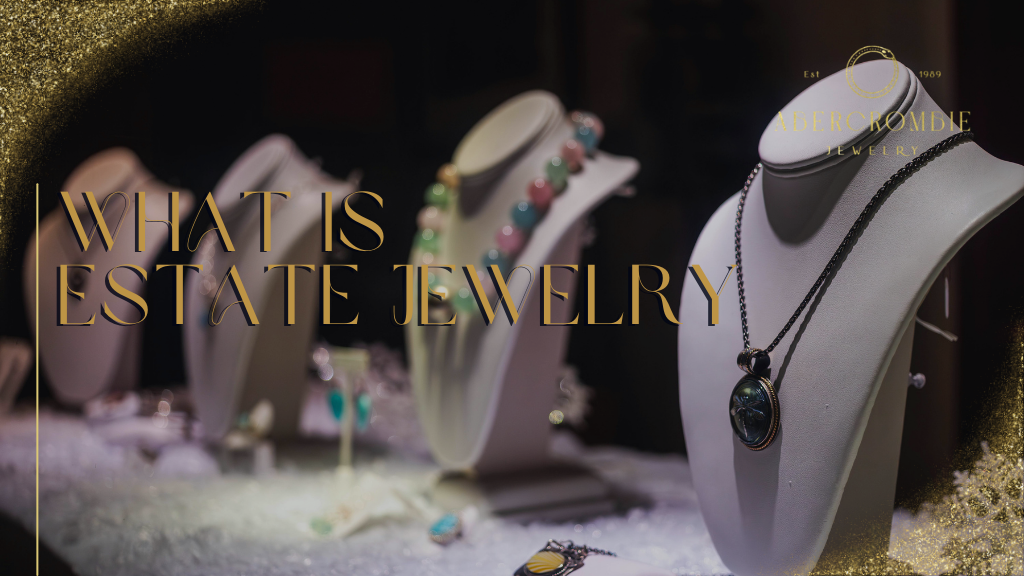What estate jewelry is? Abercrombie Jewelry gives you an in-depth guide to understanding this unique and valuable jewelry category. Estate jewelry refers to previously owned pieces, often with historical or antique significance. In this guide, we’ll explore the history, value, and critical characteristics of estate jewelry, helping you to identify genuine pieces and appreciate their timeless beauty. Whether you’re a collector or simply curious, this comprehensive guide will provide all the information you need about estate jewelry.
Many people love adding pre-owned jewelry pieces to their collection, and with good reason. It cannot be easy to find a specific style you’re looking for, and you never know when you’ll feel like giving one of your outfits a unique look. This brings us to today’s question, “What is estate jewelry?
What Is Estate Jewelry?
In simple terms, estate jewelry is previously owned jewelry. These items are often passed down over the years, generally after the previous owner’s death. Thus, many people tend to inherit estate jewelry.
However, it is irrelevant whether it was from the Victorian era, Georgian era, Arts and Crafts Era, Art Deco period, or Art Nouveau era. As long as it is pre-owned, it will qualify as estate jewelry. Most estate jewelry pieces are unique and have personal style characteristics, diamond cuts, filigree designs, and more.



Characteristics of Estate Jewelry
Even though every piece of estate jewelry differs, they are usually all high-quality items as they’ve withstood the test of time. Since not all jewelry is created with great care and premium materials, the knowledge that a prior owner has treasured an estate piece gives you peace of mind about its longevity.
In addition to the fact that only the finest and most durable pieces survive, many lesser-quality pieces usually break apart or get deconstructed to fit changing jewelry styles. These factors all contribute to the design of estate and antique jewelry.
What Are the Benefits of Estate Jewelry?
Here are the main benefits of estate jewelry:
Valuable
Many collectors find these items extremely valuable because estate jewelry has a story attached. Furthermore, you’re spoiled for choice when buying estate jewelry, as you can choose from various options, such as necklaces, rings, bracelets, and more.
Makes Traditional and Classic Styles Available
If you prefer older diamond cuts, diamond estate jewelry is ideal as it often incorporates traditional designs that are no longer used. The old techniques of hand-shaping diamonds by candlelight are no longer used due to their inefficiency with the advancement of current diamond-cutting technologies.
Because some are recut and polished into contemporary styles, the number of historic diamond cuts is scarce. Therefore, since estate jewelry has special attributes, people who appreciate the romantic beauty of an Old Mine-cut or Old European-cut diamond will be drawn to these pieces.
Eco-friendly
Buying pre-owned jewelry, such as estate pieces, is also better for the environment as no waste is produced in creating new items.
Higher Quality and Holds Historic Value
Furthermore, estate jewelry often becomes a family heirloom as it holds significant historical value and is made of higher-quality materials. These pieces are timeless and classic, meaning they can be worn and loved for future decades.
Next to Read: Estate Jewelry Appraisal: Determining the Value of Inherited Jewelry
What’s the Difference Between Estate, Antique and Vintage Jewelry?
People use the terms estate, antique, and vintage jewelry interchangeably; however, these are not the same. The significant distinctions between these three classes stem from how old the item is and whether it was previously owned or not.
Estate jewelry needs to be previously owned. Unlike antique jewelry, it doesn’t matter whether the item was passed down or how old it is.
Antique jewelry, on the other hand, must be over 100 years old. These items typically have a history associated with them and are believed to be very precious and rare.
Lastly, to be considered vintage, jewelry must be between 50 and 100 years old.
Further distinctions can also be drawn between the Art Nouveau and Art Deco periods. Art Nouveau jewelry features nature-inspired designs, such as snakes, peacocks, dragonflies, floral and leaf patterns, and the female silhouette.
However, Art Deco is about creating timeless jewelry incorporating diverse materials, bold colors, and geometric shapes. Diamonds, sapphires, rubies, and emeralds were also very common during this period.
Final Verdict
While often misunderstood, age has nothing to do with whether or not a piece of jewelry is considered “estate.” You have estate jewelry as long as you have a previously owned item. However, don’t be discouraged; these pieces are considered highly valuable, desirable, and premium.

